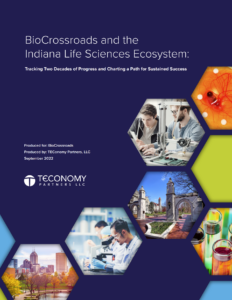 INDIANAPOLIS (Oct. 6, 2022) – Today, BioCrossroads released a new report from TEConomy that follows the impact of BioCrossroads and Indiana’s life sciences sector over the last two decades — BioCrossroads and the Indiana Life Sciences Ecosystem: Tracking Two Decades of Progress and Charting a Path for Sustained Success. The study highlights statistics that include the life sciences sector’s outperformance of Indiana’s economy since 2001 and outsized portion of total new jobs in the state over the past two decades.
INDIANAPOLIS (Oct. 6, 2022) – Today, BioCrossroads released a new report from TEConomy that follows the impact of BioCrossroads and Indiana’s life sciences sector over the last two decades — BioCrossroads and the Indiana Life Sciences Ecosystem: Tracking Two Decades of Progress and Charting a Path for Sustained Success. The study highlights statistics that include the life sciences sector’s outperformance of Indiana’s economy since 2001 and outsized portion of total new jobs in the state over the past two decades.
The report points out that “over the course of the next decade, it is expected that the life sciences will remain a key strategic driver of economic development in Indiana.”
Although the life sciences represented just over 2% of the state’s total jobs in 2020, they contributed 23.7% net new jobs from 2001 to 2020. Of the nearly 50,000 new jobs created in Indiana from 2001 to 2020, 12,000 were added in life sciences.
“BioCrossroads’ emphasis on enhancing the sector through collaborative initiatives, capital, talent, and awareness has uncovered unique opportunities over the last twenty years,” said Patty Martin, president and CEO of BioCrossroads. “However, Indiana must be vigilant in maintaining the competitive edge of its life sciences ecosystem. We must remain responsive to changes in the environment that are critical for Indiana’s long-term economic competitiveness.”
Other Key Statistics:
- Indiana’s life sciences workers were also considerably more productive than the national average in 2020 ($321,094 GDP per employee in Indiana, compared to $304,673 for the nation), and in each year from 2007-2020.
- From 2001 to 2021, the number of venture capital deals and dollars supporting Indiana’s life sciences companies grew almost 10 times, increasing from four venture capital transactions totaling $14 million in 2001 to 39 venture capital transactions totaling $433.5 million in 2021.
University-related Statistics:
- Over the past two decades, academic research and development in Indiana has nearly tripled. Life sciences research at Indiana’s colleges and universities has grown from $282 million in 2001 to $844 million in 2020.
- Growth in life sciences research at Indiana’s academic institutions has outpaced the national average over the past two decades. Indiana’s 2021 academic research expenditures in the life sciences nearly tripled since 2001; the national average was 2.5 times. Indiana’s growth exceeded the nations throughout the entire two-decade period.
- National Institutes of Health (NIH) funding grew from $147 million in 2001 to $359 million in 2021. Notably, growth in NIH awards in Indiana outpaced the US average since 2001, with substantial growth in the past five years.
Healthcare and Life Sciences Regional Data
Over the last three months, BioCrossroads has released reports on the healthcare and life sciences sector that target six regions of Indiana*, including Northern (South Bend-Elkhart), Northeast, Central, Wabash Heartland (Lafayette-West Lafayette), Upland (Bloomington), and Southwest. In addition, one report, focuses on the entire state and determined that the sector accounts for one in every ten jobs, provides an annual economic impact of $150 billion and is present in the substantial assets spanning the corporate, university and philanthropic sectors.
You can view all of the reports at https://biocrossroads.com/news-reports/.
About BioCrossroads
BioCrossroads (www.biocrossroads.com) is Indiana’s initiative to grow, advance and invest in
the life sciences, a public-private collaboration that supports the region’s existing research and corporate strengths while encouraging new business development. BioCrossroads invests capital and provides support to life sciences businesses, launches new life sciences enterprises (Indiana Biosciences Research Institute, 16 Tech, Indiana Health Information Exchange, and OrthoWorx ), expands collaboration and partnerships among Indiana’s life science institutions, promotes science education and markets Indiana’s life sciences industry.
*based on the most recent numbers available
